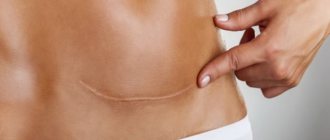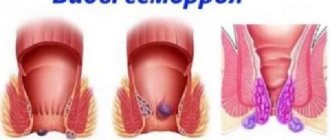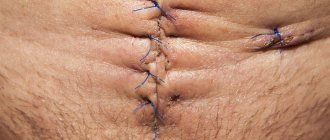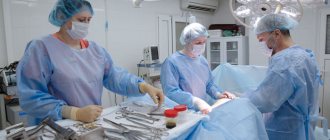When is a caesarean section indicated?
Sometimes caesarean section
prescribed for medical reasons even before the onset of the first contractions.
Planned caesarean section
prescribed for an anatomically narrow pelvis in a pregnant woman, with complete placenta previa, or if the previous pregnancy was also resolved by cesarean section and a scar on the uterus with signs of thinning. Also among the reasons for which a planned cesarean section is prescribed: severe gestosis during pregnancy, the presence of chronic diseases in the mother such as heart disease, diabetes, hypertension, kidney disease, in which natural childbirth poses a risk, as well as exacerbation of genital infections at the time of birth (for example genital herpes).
Sometimes the mother herself chooses the option of a cesarean section, but, as a rule, in the absence of serious complications, doctors strongly recommend natural childbirth.
Enema before caesarean section
The birth of a child through surgical intervention is being practiced more and more often. The reasons for this decision are varied. The main factors leading to the inevitability of a CS:
- The risk of a threat to the health and life of the baby during natural childbirth.
- There is a high risk of loss of health or death of the mother if the child is allowed to be born independently.
As a rule, this operation is planned. The exception is natural childbirth with complications, when only a CS can save the mother and baby.
Any surgical intervention involves performing enema procedures and cleansing the intestines of contents. An enema before a cesarean section will avoid unplanned penetration of feces into the wound and the development of secondary infection. Additionally, an enema before childbirth greatly facilitates the postpartum period and speeds up recovery.
CS is a violation of the integrity of the skin of the abdomen, the inner layer of the epidermis and the uterus. In the first postoperative days, attempts to tense the abdominal muscles will be painful, even when taking painkillers. Therefore, a clean intestinal tract will eliminate the need to visit the toilet on these days and will reduce pain until the stitches are completely healed.
Also, performing forced cleansing of the intestinal tract during cesarean section has a preventive effect. After childbirth or surgery, it is often observed that women cannot go big. Fecal masses release toxins and gases, bloating and pain occur, inflammatory processes develop, and the risk of complications increases.
Is this necessary?
When there is no content in the intestines, there is no pressure on the uterus. This is considered the main reason why the doctor sends a woman in labor for enema procedures. First of all, this makes the surgeon’s work easier and guarantees high-quality surgery. The risks of developing infection at the incision site are minimized. A free bowel is important in the postoperative period, when any tension or contraction of the uterus causes discomfort. It hurts to laugh, cough, sneeze.
Giving an enema before surgery will ensure that the next three days are free from the urge to go to the toilet. The stitches will heal faster and the risk of their rupture will be reduced. But additional actions are required from the woman. First of all, you will have to switch to a strict diet that prevents excessive stress on the intestines. The absence of unnecessary discomfort speeds up healing. In the period after surgery, if feces are retained, doctors' recommendations speak in favor of microenemas or suppositories. The drugs will have a mild laxative effect, which will allow you to empty your intestines without effort and tension in the abdominal muscles.
Proper execution
As a rule, during planned surgery, an enema is given in the morning. A pregnant woman will have to wake up early for the procedure.
Everything happens in a separate room, where there is a toilet and a bathroom for washing. The patient lies on her side, the tip of a rubber hose, lubricated with fat, is inserted into the anus. The clamp opens and fluid flows into the colon. The nurse should supervise the insertion process. An important point: water is introduced warm to relax the intestines as much as possible and gently remove fecal matter. Using cold water will have the opposite effect. Phenomena of spasms occur in the intestines and are transmitted to the vessels. This will provide negative consequences for both organisms.
Two liters of water are prepared for administration. But in the process of manipulation they are guided by the situation. Often the amount of liquid used for enema procedures is taken less. This is connected with the woman's feelings. Often the procedure is stopped due to a feeling of fullness, causing pain.
After adding water, you should wait ten minutes. Next, the pregnant woman goes to the toilet and emptys the intestines of the contents. Taking a bath and shaving your pubic area is preparation for surgery. It is worth noting that you cannot eat after cleaning the organ, since anesthesia is planned.
Do all maternity hospitals give enemas to pregnant women?
Today, many maternity hospitals have refused to perform mandatory enema procedures. First of all, this applies to private clinics. But more and more often, state medical institutions are performing this manipulation at the request of a pregnant woman.
The reasons for refusing enemas were refutations of facts that have long been considered the basis for cleansing the intestines before childbirth:
- Based on numerous studies conducted in America, evidence was obtained that the procedure of forced cleansing of the colon and rectum does not affect the birth process. It doesn't speed up or slow down. Previously, official medicine had a different opinion.
- Often the final evacuation does not take place, and already at the beginning of efforts to push the child out of the anus, the remains of feces, liquefied with water, come out. Therefore, gradually obstetricians began to come to the conclusion that a single bowel movement during childbirth is better than constantly flying pieces that pollute more space.
- Official medicine, when doing an enema, stated: if the intestinal tract is full and emptying begins during childbirth, then the child’s body can come into contact with feces and become infected with the microbes present there. However, the above studies suggest the opposite. During childbirth, bowel movements occur before the baby's head appears. Thus, contact between feces and the child is excluded.
- Natural childbirth is becoming popular. In this case, enema procedures are not provided.
You need to find out in advance whether the maternity hospital where the woman is going to give birth conducts enemas.
In what cases is an emergency caesarean section performed?
It happens that the mother was preparing for a natural birth, but an emergency caesarean section is prescribed. Sometimes this happens in the last weeks of pregnancy or even during childbirth. For example, in such situations: the mother develops preeclampsia or placental abruption has occurred, the cervix stops dilating during contractions, the uterus ruptures, Also, an emergency caesarean section is indicated if the fetus has an abnormal heartbeat or distress syndrome has developed, or if the baby is not moving along. birth canal.
Doctors' opinion
The question of the advisability of artificial bowel cleansing is commented on by obstetrician-gynecologist of the highest category Fedor Aksenov: “The topic of whether to prescribe or prohibit enemas for expectant mothers is one of the most pressing issues among doctors recently. I should note that there are exactly as many supporters of this procedure as there are opponents. Personally, in most cases, I recommend that my patients cleanse the intestines to avoid many inconveniences and eliminate possible complications during the delivery process. Yes, I must admit that this procedure is unpleasant, but there is nothing terrible about it, considering how quickly it is carried out and how carefully it is done by our nurses. The main thing for the patient in this matter is the right attitude. I am especially surprised by the fear of this procedure before childbirth - in the maternity hospital, a woman suffers such agony that an enema cannot be compared with it.”
How is a caesarean section performed?
As with any operation, before a cesarean section, medical preparation is carried out, an IV with fluids is placed, and the skin is treated with an antiseptic. In some cases, anesthesia may be an epidural or spinal, in other cases, especially in the case of an emergency caesarean section, general anesthesia is performed.
The surgeon makes a horizontal incision 10-15 centimeters long along the pubic bone (along the bikini line). He then separates the abdominal muscles with a scalpel and makes a through incision into the uterus. You may experience a slight tugging sensation as you remove the baby. The doctor then cuts the umbilical cord and removes the baby.
Immediately after birth, you will be allowed to look at the baby, but not for very long, because doctors need to measure his pulse and temperature and evaluate the color of his skin. While the baby is being examined, the placenta is removed, the uterus is sutured, and an incision is made in the abdomen. You will also be given antibiotics to prevent infection.
You will then be moved to the recovery room for observation for a few hours. During this time, you can hold your baby, try breastfeeding, and hold him close to your skin.
Before surgery
Firstly, it is better to go to the maternity hospital in advance, at least 1-2 days in advance. During this time, you will get used to the hospital atmosphere, pass all the tests, and meet the doctor. You will also chat with other girls waiting for their “finest” hour. Their support and advice will be very helpful in the future.
Secondly, prepare for surgery. Morally! Calm down, get a good night's sleep the night before; If you can't sleep, ask the nurse for some sedative. Also pack the bag in the recovery room. You will need a bottle of mineral water without gases, a mug, clean panties (preferably with a high elastic band so that they don’t put pressure on the seam), pads, and a phone.
An anesthesiologist will visit you on the eve of the operation. Answer all his questions, tell him about all the illnesses and injuries that you have had during your life. This could be very important. Ask any questions you have about anesthesia. Personally, I chose epidural anesthesia because... it does not affect the child, it is easier to get back on your feet later, doctors can always find out about your well-being from you and, most importantly, you will immediately see your child and hear his first cry! With general anesthesia, the child is more lethargic, you will see him only after you wake up. And this is fraught with psychological difficulties - for some it will be difficult to realize that this is their baby, and all because they did not see the moment of his birth. And this is already scary! I will write further, implying that the anesthesia is local.
Thirdly, nutrition on the eve of surgery. You can have a hearty breakfast, a light lunch without meat, until 6 pm you can have kefir and yogurt. After 6 only water, tea without sugar. It is recommended to drink at least 1.5 liters of liquid.
Fourthly, an enema. It is recommended to do it in the evening and morning before surgery. But you can only get by in the morning if you ate a little yesterday.
Fifth, you will have to shave. So don't forget a disposable razor.
How long does it take to recover after a caesarean section?
Recovery is an individual process, but in general it takes longer to recover from a cesarean section than from a vaginal birth. As a rule, after a cesarean section, the mother remains in the hospital for several more days, and doctors monitor her health and the healing of the postoperative wound.
Try to get plenty of rest, although it’s not easy with a newborn baby. Do not lift anything heavier than the baby, regularly wipe the post-operative scar with an antiseptic to prevent infection. Choose loose clothing to prevent chafing and irritation in the scar area. Don't drive or exercise until your doctor tells you to (usually two to four weeks after giving birth). Recovery after a caesarean section without complications takes 4-6 weeks.
What can you eat after giving birth?
Hospitals receive parcels for young mothers every day at certain hours. Mom can eat lean boiled meat, fish, poultry, broths, and fermented milk products. A list of what can and cannot be transferred is always posted in the hospital in a place visible to visitors. You can transfer: green apples, mineral water, low-fat natural fermented milk products, boiled meat, fish, poultry. It is clear that you can bring a little of everything for the young mother so that the food does not spoil.
Discharge home If the birth was without complications, on the 3-5th day the mother and child are discharged home. Before discharge, the mother will definitely undergo an ultrasound of the pelvic organs. Upon discharge, the woman will be given 2 completed parts of the exchange card. The first part is for the antenatal clinic: it contains information about the woman in labor and the peculiarities of the course of labor. The second part is for a children's clinic, it contains information about the newborn. The day before discharge, the neonatologist at the maternity hospital calls the medical institution where the parents intend to observe the baby and reports about the newborn. Also, in the maternity hospital, the young mother must be given a very important certificate about the birth of the child. This certificate indicates the date of birth of the baby, the time of day when he was born, the medical institution where the birth took place, the city, country and the parameters with which the child was born. The same certificate must indicate the surname, first name, patronymic, year of birth of the mother, birth history number and surname of the doctor who helped the child be born. Based on this certificate, you will need to obtain a birth certificate for the child from the registry office.
Is it possible to feel contractions and other labor symptoms during a cesarean section?
If you have a planned caesarean section, it is usually done before contractions start, so you won't feel them. But sometimes, after contractions begin, the mother may need an emergency caesarean section. So whether you're preparing for a C-section or not, it's worth familiarizing yourself with the signs of labor you can expect in the third trimester, typically between 38 and 42 weeks.
And remember, doctors and other hospital staff will be able to take care of you, regardless of whether you have a cesarean section or a vaginal birth.
Day "X"
The nurse will wake you up in the morning for the enema. Then they will bandage your legs to the knees with an elastic bandage (you need to purchase it in advance, one 3-4 meter is enough, they will simply cut it in half). This is necessary because the blood flow of the lower extremities is disrupted, and to prevent damage to the veins, you need to wrap your legs. The bandages can be removed as soon as you get out of bed.
You should not drink water before surgery! So you'll have to be patient.
At the appointed time, you go to the operating room with a bag of things. The nurse will help you put on a sterile shirt, cap, and shoe covers. The anesthesiologist will give an injection in the back, after which the legs gradually begin to go numb. Therefore, you need to lie down quickly while you are able to do it yourself. The next step is to insert a urinary catheter, this is no longer painful, because... painkiller works. On the table, the incision site will be treated with alcohol and iodine. They will hang a curtain in front of your face so that you cannot see anything. An IV will be connected to your right arm, and a blood pressure cuff will be placed on your left arm. He will be monitored throughout the operation. The doctor makes a test incision, and if there is no sensitivity, the operation can be considered to have begun.
During the operation, the only moment associated with painful sensations is the process of delivering the child. But this is tolerable and is rewarded by the baby’s first dissatisfied cry. You will hear it approximately 10 minutes after the start of the operation. They will show you the child and take him away for processing. All. All you have to do is wait until they clean you up and sew you up (about 30 minutes).
Preparation
- 7 - 10 days before the expected date of birth, you will be hospitalized in the antenatal department of the maternity hospital and a date for surgery will be set. Typically, PCS is performed at 38–39 weeks.
! In many modern maternity hospitals, the expectant mother is allowed to come to the ACL on the day of the operation.
- For ACL, you will need to buy special compression stockings or bandages to protect the vessels of the legs from the formation of blood clots;
- On the day of the operation you should not drink or eat - the doctor will remind you of this;
- Two hours before the PCS, you will have a cleansing enema.










